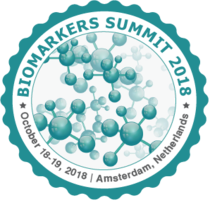
David G Ostrow
International Cannabis Cancer Treatment Institute | USA
Title: Entourage of biomarkers resulting from the binding of cannabinoids to their receptors: a review and research opportunities
Biography
Biography: David G Ostrow
Abstract
In trans-membrane signaling, interactions between agonists and their receptors cause a cascade of effects. Since phytocannabinoids contain many active ligands, and the internal endocannabinoid system has multiple receptors linked to a variety of secondary messengers, these complex mixtures can have widely varied effects based on the ratios of cannabinoid molecules, their routes of administration and the specific cells and organs targeted. Thus, the use of biomarkers has the potential to clarify the pathophysiology of the condition or symptom being treated and the mechanism(s) by which cannabinoids restore homeostasis and health. We present an extensive review of findings on six major receptors with high affinity for (Endo) cannabinoid molecules that demonstrate the common pathways and secondary feedback loops that shift MAPK signaling, cause changes in biomarkers, and restore cellular functions and homeostasis: CB1, CB2, PPARg, GPR18 and 55, and TRPV1 are covered. In both animal and in vitro studies, it was found that the cannabinoid receptors (CB1 and CB2) and GPR18 and 55 function antagonistically due to co-expression on the surface of cells. GPR18 is co-located with CB1 and GPR55 with CB2. Later, along with increased levels of lysophosphatidylinositol (LPI), itself being a membrane biomarker for decreased survival in multiple cancers. Agonist binding to both CB receptors inhibits adenylyl cyclase, halting the MAPK pathway, thereby limiting cancer cell migration and metastasis; stimulation of GPR receptors does the opposite. CB2 mediated responses reduce inflammatory markers such as IL-2, TNFa, and neutrophilia: its associated GPR55 has opposite effects. GPR18 agonist improves cardiac function and reduces markers of cardiomyopathy, as well as promoting the destruction of infectious agents. Autism is associated with mutations of the CB1 receptor and GPRs. Effects at PPARg were found to reduce glial cell activation and halt the production of fibrillary tangles and the resulting formation of amyloid beta plaques causing Alzheimer’s. Conventional diabetes medicines act at this receptor as well, possibly explaining the association seen between diabetes, insulin resistance and early onset AD. TRPV activation by cannabinoids was found to promote apoptosis of cancer cells by inactivation of the MAPK pathway and activation of caspases. In the case of capsaicin activation, influx of calcium through opening of Ca+ channels occur in contrast to cannabinoid binding. This produces an endogenous entourage effect through increased levels of anandamide and its co-synthesized analogues OEA and PEA. CB1 activation in the CNS produces a similar entourage of lipid biosynthesis that regulates glutamate and GABA neurotransmission. These encouraging results from in vitro and rodent models are beginning to be translated into controlled human trials of cannabinoid treatment of Alzheimer's, CVD, cancer, chronic pain, and autism that utilize appropriate biomarker measures to supplement the long-term clinical endpoints of chronic disease.

